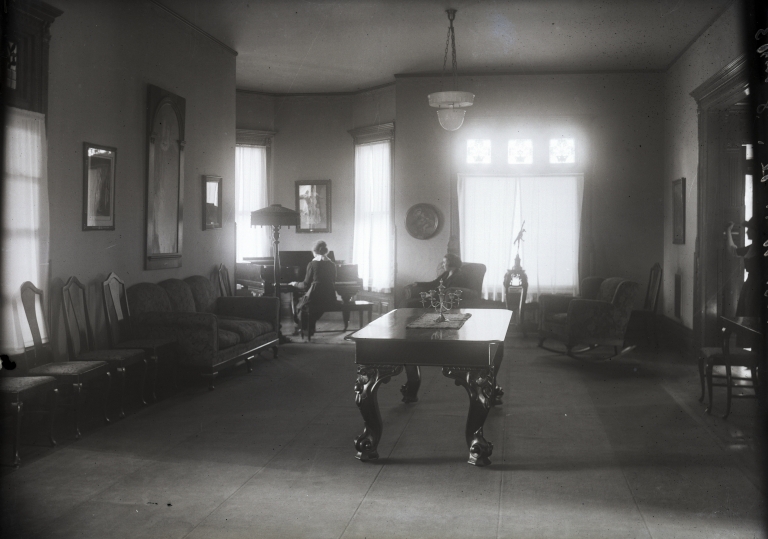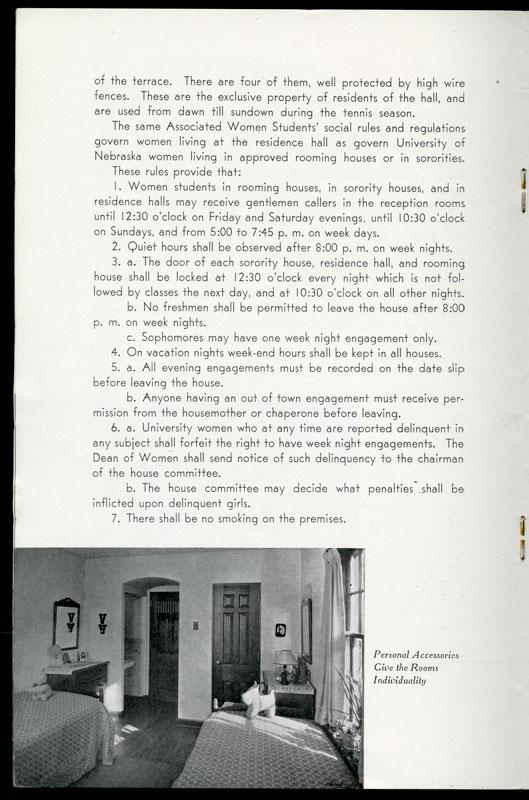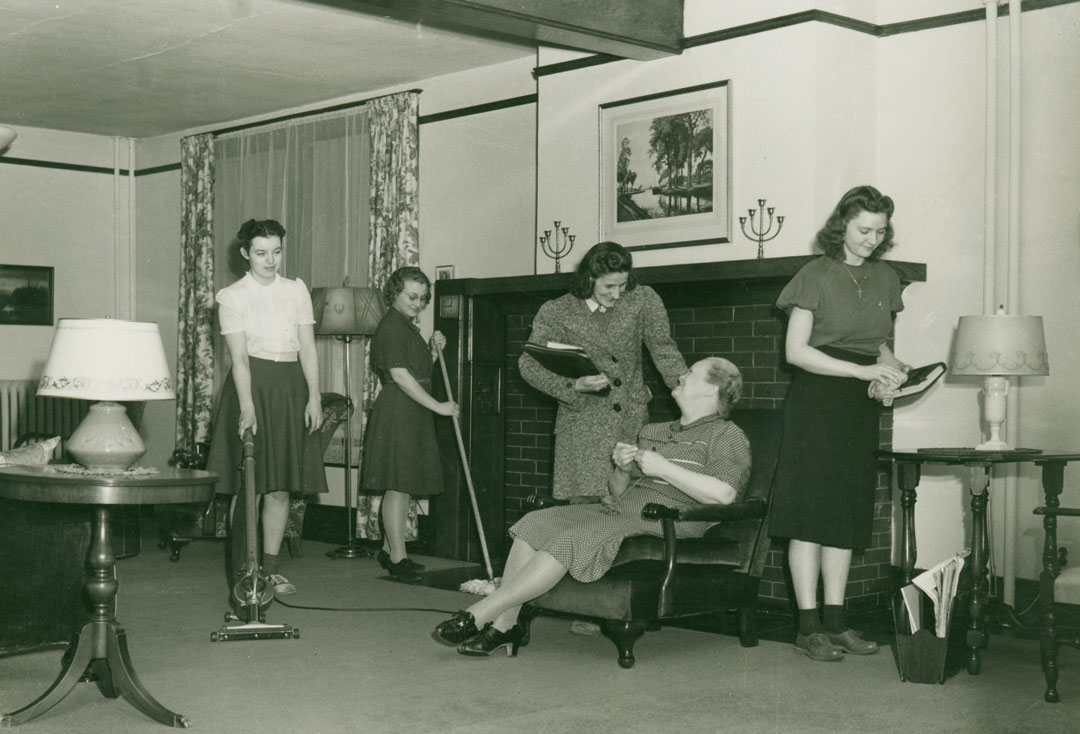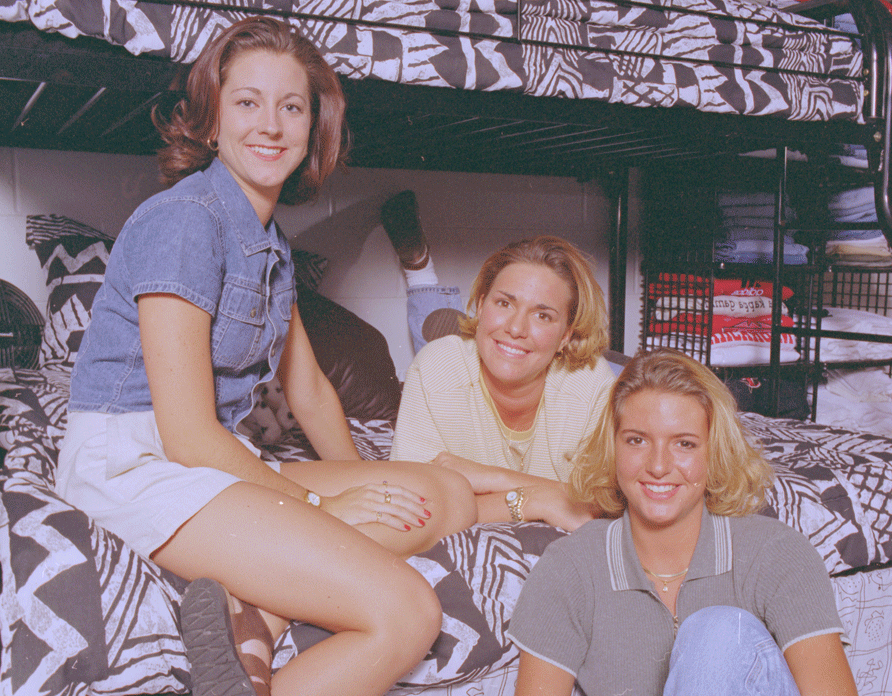Cottages, Curfews, and Co-Eds
A History of Women's Housing at the University of Nebraska - LincolnThe landscape of on-campus housing has changed significantly throughout the history of the University of Nebraska-Lincoln. This exhibit focuses on the experience of female UNL students, who, at various points in time, lived in cottages in the city of Lincoln, were given a curfew and dress code in the dorms, or were restricted from receiving male visitors in their co-ed dorms. The change to housing as we see it today was a slow journey, but this exhibit takes you along as UNL progressed from cottages to curfews to co-eds.



Cottage Era, 1869-1930
When the University opened its doors in 1869, one thing missing from the campus was student housing. Students lived either in Greek houses, with their parents, in boarding houses in Lincoln, or in cottage dorms. Constructed from old houses on Q and R streets, the cottage dorms were cooperative houses. They were called cottage dorms to emphasize their domestic quality. Because the cottage dorms provided space for only 150 women, other students lived in boarding houses around Lincoln.
Boarding Houses
Female students were required to find a boarding house from an approved list made by the Dean of Women. The Dean of Women and the bureau of housing held high standards for the boarding houses where they would send students, and even removed one boarding house from the list for not having an acceptable parlor where women could take tea. However, many male students found the boarding houses around Lincoln were inhabitable, with “wallpaper falling off… exposed wires and tumble down beds.”
“The walls were of smooth plaster painted a cold, pale green, but I noticed with pleasure that there was an upright piano in one corner of the front room. There was a small center table with a Welsbach burner lamp and a copy of the Ladies Home Journal. Everything looked absolutely clean and in perfect order.”

Lincoln, Nebraska circa 1870
Cottage Dorms
Cottage dorms were renovated from houses on Q & R streets. Students who lived in these houses did their own cooking and cleaning. The concept of this form of less expensive student housing was popular with men and called “cooperative housing”. The university owned cooperative housing for both men and women, but they called the houses for women “cottage dormitories” to emphasize their docile, feminine quality.
Ellen Smith Hall
Renovated from a community member’s house, Ellen Smith Hall served as both an office for the Dean of Women and as a living space for students. The Association for Women Students (AWS) and Young Women’s Christian Association (YWCA) held their meetings in Ellen Smith Hall. There were frequent social events, such as dances, in the hall. The hall had a parlor and study area. Students got their meals from the Temple Building on campus.
Photo 1: Exterior of Ellen Smith Hall; Photo 2: AWS meets in the parlor; Photo 3: A resident plays piano while another resident listens; Photo 4: Women socialize in the parlor; Photo 5: Residents dress in costume for a YWCA meeting
Scroll through the photos to see what life in Ellen Smith Hall was like!
“A building for University girls, it is shared by all the women connected with the University.”
Curfew Era, 1930-1970
By 1930, students were calling on the university to establish on-campus housing options. Students felt leaving campus after classes decreased their sense of social unity, and parents were concerned allowing students to live in the city without direct supervision would tempt them into social vices. Male students who were not in Greek life, called “barbs,” opposed the creation of dorms because they were aware dorms meant regulation. They argued “dormitories may be alright for girls,” but “men are perfectly capable of taking care of themselves.” With all of this under consideration, the university announced in 1931 that it would be constructing the first dorm on campus, Raymond Hall, which would house freshman women.
In order to curb the bad influences of college, UNL imposed rules on the residents. These rules included dress codes and curfews. There was a curfew of 9 p.m. for freshmen and 10:30 for older students. While the door would be locked after curfew, many women learned how to work around the rules. Some knocked on windows or had older residents unlock the door for them, although punishment for getting caught meant having a week-long curfew of 7 p.m. Women had to wear skirts and heels at dinner every day but Saturday, and jeans were strictly forbidden. Men had to wear ties and jackets if they wanted a meal from a women’s dining hall. It wasn’t until 1952, when a men’s dorm opened, that any sort of dress code for men was imposed outside of meals.
Wearing jeans and shorts downtown, in the dorm lobby, in Raymond parlors, in the dining hall, on campus or to football and basketball games just is not done at Nebraska. Tennis matches, picnics and special occasions are exceptions, and jeans may be worn to dorm breakfasts and lunches on Saturdays only.
Raymond Hall | 1932
Raymond Hall had a dining hall, a social parlor known as the “knotty pine room,” and a recreation room. The dorm operated under a policy of loco parentis, meaning the university acted in the role of a parent. House mothers were one of the policy enforcers who acted as a parent towards university women. They were responsible for ensuring women had skirts on for dinner and were in their dorms by 8 p.m. At the University of Michigan, which had a similar curfew, one alum described the moments before curfew hit, saying: “Everyone was lined up kissing their boyfriends. The poor housemother had to stand at the door watching it all and waiting for it to end every night.” Raymond Hall was opened to male residents and renamed Neidhardt Hall in 1973.
“We’d get hungry so we’d phone down [to Owl Diner] for sandwiches and malts… and we’d tie bed sheets together, go out on the balcony and lower our bedsheets and had [a delivery man] tie on the food”
Scroll through the pictures to see snippets of what life in Raymond Hall was like!
Photo 1: Exterior of Raymond Hall; Photo 2: Raymond Hall dining room; Photo 3: Residents use the Raymond hall kitchenette; Photo 4: Residents socialize with their dates by the front doors; Photo 5: Residents have tea in the parlor; Photo 6: Residents and guests play ping pong in the game room Photo 7: Residents get mail from the front desk; Photo 8: Residents lounge in their dorm room
Love Memorial Hall | 1942
Love Memorial Hall opened in 1942 as a space for female home economics majors. The dorm modified the idea of “cooperative housing” from the cottage dorm era by creating a house where the residents did all the cooking and cleaning themselves. The residents were divided into units that rotated kitchen patrol and cooking. This allowed the dorm to cost half as much as other housing options. Because residents shared classes and a living space, Love Memorial Hall was a close-knit dorm and still boasts an active alumni association.“We learned a lot, and we formed many warm, lasting friendships. And we did study some, too.”
Photo 1: Exterior of Love Memorial Hall; Photo 2: Residents make food in the kitchenette; Photo 3: Residents socialize on the front steps; Photo 4: Residents sit down for the meal they’ve prepared; Photo 5: Residents socialize in their dorm room; Photo 6: Residents serve food; Photo 7: Residents socialize in the lounge; Photo 8: Residents clean the lounge and talk to the housemother
Scroll through to see photos of life in Love Memorial Hall!
International House | 1944
In 1944, the Board of Regents declared that the existing dormitories north of 16th street were only for white students and established the International House for female students of color. The University purchased the Phi Mu sorority house to be used as the International House, which could hold 33 residents. Female international students, as well as American students who were not white, were housed in the International House with roommates who expressed interest in social issues. The dorm received mixed reviews from students and community members. While some felt the house encouraged cross-cultural connections, many protested the segregation of African American students into International House. One of the most prominent voices against housing segregation was Patsy Takemoto, a UNL student who would later become the first woman of color elected to congress and an author of the Title IX legislation that put an end to women’s curfews at UNL and other universities.
In 1949, an African American student wrote to the Dean of Women, Marjorie Johnston, to ask if she could live in the dorms rather than the International House. Johnston wrote to Chancellor Gustavson to ask for guidance on the decision. Gustavson replied with a letter to both Johnston and the entire Board of Regents with his personal recommendation to end the policy of dorm segregation on campus. He noted that the policy was bound to give UNL bad publicity, and he expressed his personal concerns with the immorality of segregation. Less than a week later, UNL officially ended the policy of dorm segregation. The International House remained on campus until the 1980s, though it was eventually moved to Raymond Hall. It was much better received as a dorm for international and domestic students to collaborate than it was as a representation of campus segregation. Students even created a short-lived newspaper for “I-House” which published poems, essays, and news articles by residents of the international house.
I found that the dormitories were not open for a person like myself. Luckily the International House was waiting with outstretched arms to receive me and try to protect my interests. A wonderful thing, I say, but not as extensive as it should be.
Photo 1: Exterior of I-House; Photo 2: Roommate chat in their dorm room; Photo 3: Residents socialize with their guests in the game room; Photo 4: Residents have a meal with the house mother
Scroll through to see photos from the International House!
Co-Ed Era, 1970-Present
Prompted by limited space and a changing social landscape, UNL slowly began to integrate dorms by gender in the late 1960s and early 1970s. Burr Hall on East Campus and Selleck Hall on city campus were the first dorms to become coeducational in 1965. The dorms were split into separate buildings, meaning men and women had separate lobbies, restrooms, and entrances. Eventually, entire buildings were made co-ed, with opposite sexes placed on separate floors. Co-ed dorms were originally only allowed for older students, but as time went on, more freshman students were placed in co-ed dorms. By the 1970s, UNL was even promoting living in a co-ed dorm as a valuable educational experience.
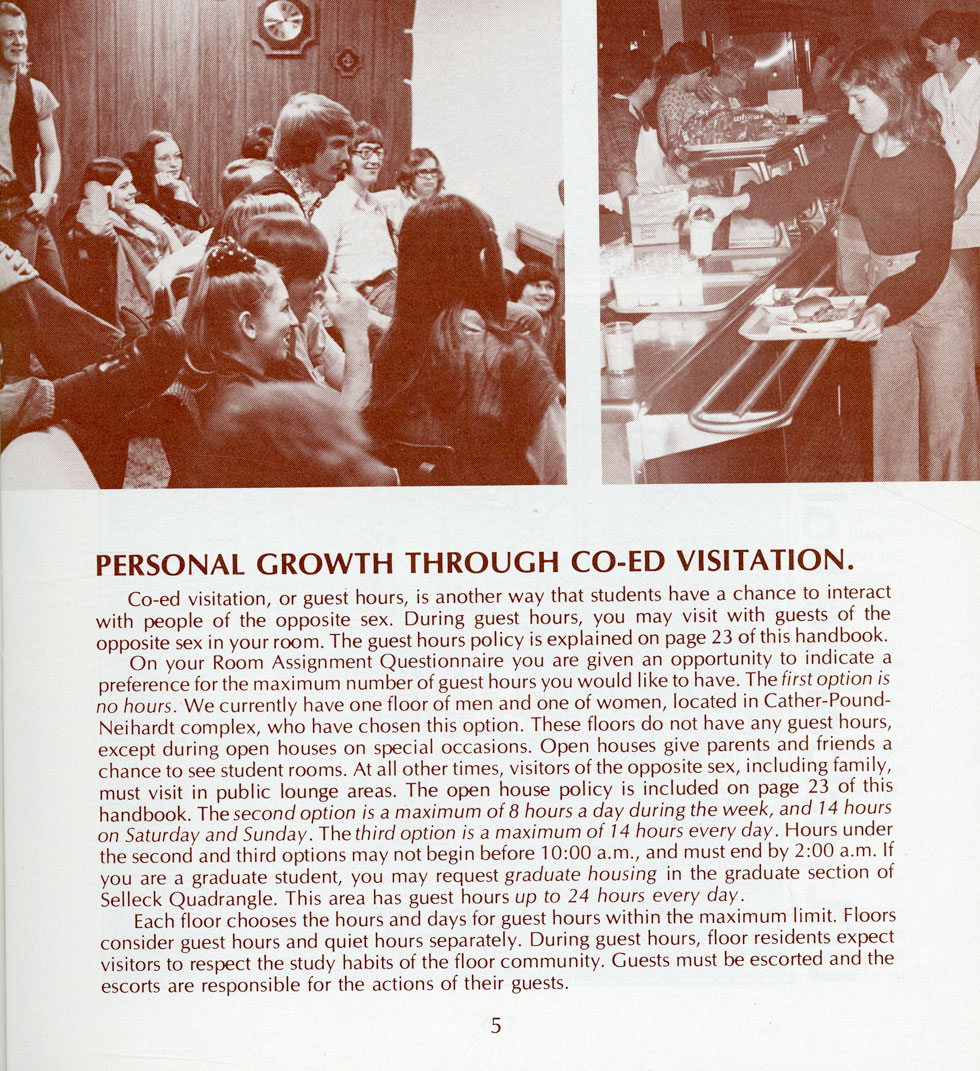
Even though co-ed dorms were gaining popularity, the curfew policy remained in effect at UNL. Single-sex dorms continued to have a sign-out sheet for women, while resident assistants and housing directors replaced house mothers. Floors met at the beginning of the year to determine their policy for visitation by members of the opposite sex. The issue of visitation hours continued to be a controversial issue across campus for years. The Residence Hall Association (RHA) oversaw several proposed bills with options ranging from completely doing away with visitation hours to making visitation hours 24/7.
The curfew policy also remained controversial on campus. In 1966, the Association of Women Students (AWS) sought to eliminate the sign-out sheet from all-female dorms such as Sandoz Hall. They argued that the system was rarely used correctly, so students were more likely to get in trouble for forgetting to sign-in than for missing curfew because they didn’t sign out. In 1970, the university agreed to a trial run of giving upperclassmen student keys and extending the curfew to midnight. After a semester of success, the policy was applied to the whole campus.
Harper-Schramm-Smith Complex | 1970
The three dorms in the Harper-Schramm-Smith (HSS) complex are rarely referred to by their individual names at UNL today, but when the dorms were constructed in 1968 they each served a defined purpose. Smith Hall, named for the original Ellen Smith hall, was the only all-female dorm of the three. Harper Hall was all-male, and Schramm Hall became co-ed in 1970, two years after the construction. Housing officials were open to the idea of co-ed dorms, but did not expect it to catch on. The housing director was quoted in the student newspaper as saying, “The trend is to liberalize housing, but that would be a drastic mistake considering the number who want the conservative, or single-sex, option.” The co-ed option turned out to be popular with students, however, and UNL added more co-ed floors to previously all-male dorms.
“It’s common for groups of persons, men and women, to go out for coffee of doughnuts on a weeknight. People in Schramm do things in groups rather than in boy-girl pairs. Residents say most relationships are on a friend level rather than romantic, though a few romances have developed.”
Photo 1: Exterior of the HSS complex; Photo 2: Co-ed residents socialize in a dorm room; Photo 3: A resident studies in her dorm room; Photo 4: Residents socialize in the lounge; Photo 5: Residents pose for a photo on their bunk bed in Smith Hall; Photo 6: Residents talk on the steps outside of Harper; Photo 7: A resident gets her mail from the Smith desk; Photo 8: Residents pose on the steps by Schramm hall
Abel-Sandoz Complex | 1974
While originally built as a men’s dorm in 1965, Abel Hall opened 80 rooms on two floors to women in 1974. There were concerns that turning a men’s dorm into a co-ed dorm would make the hall “a big sex orgy thing,” but the residence director assured the public that students would “have the right attitude about it” and therefore benefit from living in close quarters with the opposite sex. After the popularity of Schramm Hall, students found the atmosphere of co-ed housing desirable, and more dorms adopted the co-ed model. Sandoz Hall, the all-female dorm constructed beside Abel, was the first all-female dorm to push for the removal of the curfew. Sandoz was turned into a co-ed dorm shortly after Abel Hall, though it is still popular with mostly female students today.
“The atmosphere is easy-going and friendlier than an all-male dorm”
Photo 1: Co-ed students socialize on the steps of Abel hall; Photo 2: A man carries a tray for a woman in the Abel cafeteria; Photo 3: Women play cards on their bed; Photo 4: Female residents sign out from on a bulletin board; Photo 5: Residents flirt in the Abel cafeteria; Photo 6: Residents walk out of Abel Hall; Photo 7: Residents get food from the Abel cafeteria
Current Dorms
Today, students at UNL have a choice between a fully gender-divided dorm, a gender-divided floor in a co-ed hall, a co-ed floor, and even a co-ed room. Love Memorial Hall remains open exclusively to female-identifying students. “Traditional” halls, that is, freshmen dorms like Harper and Abel, are all co-ed but divide students onto different floors by gender. These dorms have shared bathrooms, so you can only find a women’s restroom on a floor assigned to female students. Suite Style dorms, which fit rooms of 2 to 4 residents with a private bathroom, have co-ed floors. These halls are open to freshman and upperclassmen alike. Recently, the university also created a gender-inclusive housing model which allows students in certain dorms to opt in to living in a dorm room which does not assign students by biological sex. While this was designed to accommodate transgender students, it allowed any UNL student to reside with people of a different gender. It is a popular option for heterosexual students who want to live with their partner in an on-campus dorm. The landscape of today’s on-campus housing would certainly be unrecognizable to the women of the 1930s who were told what to wear and when to be back at the dorm.
Discussion Questions:
How did the landscape of housing impact students’ experiences at UNL?
In what ways has housing changed since the university’s establishment in 1869?
How did the culture of Nebraska and the U. S. influence the rules of housing?
In what ways did rules that seemingly applied to everyone impact some populations more than others?
Did the rules of housing impact relationships between male and female students? If so, how?
Sources
“Chapter History” Phi Mu at University of Nebraska-Lincoln http://unl.phimu.org/chapter-history
“Curious Cornhuskers: When Did Abel Hall Become a Coed Dormitory” The Daily Nebraskan December 3, 2018. https://www.dailynebraskan.com/news/curious-cornhuskers-when-did-abel-hall-become-a-coed-dormitory/article_ad559252-f6aa-11e8-a25d-af85d9c0c13c.html
Davis, Jennifer “Life Under Curfew” University of Michigan Alumni Association https://alumni.umich.edu/michigan-alum/life-under-curfew/
“Dormitory Plan is Opposed by Barb Students” The Daily Nebraskan December 9, 1930, page 3. Nebraska Newspapers https://nebnewspapers.unl.edu/lccn/sn96080312/1930-12-09/ed-1/seq3/#words=Dorm+dormitories+Dormitories+DORMITORY+dormitory+house+HOUSE+House+houses+housing
Fullerton, Jim “Visitation Suspended in Schramm, Smith Halls” The Daily Nebraskan January 30 1974. The Daily Nebraskan https://nebnewspapers.unl.edu/lccn/sn96080312/1974-01-30/ed-1/seq-1/#words=Schramm+Schramm%27s
Jepsen, Sue “1932-1983: Half Century of Changes Have Passed Through Hall” The Daily Nebraskan March 28, 1983. Nebraska Newspapers https://nebnewspapers.unl.edu/lccn/sn96080312/1983-03-28/ed-1/seq-1/#words=Co+ed+Raymond
Kirk, Ken “Schramm: A Dorm of a Different Gender” The Daily Nebraskan April 13 1973, page 7. Nebraska Newspapers https://nebnewspapers.unl.edu/lccn/sn96080312/1973-04-13/ed-1/seq-13/#words=Schramm
Knapp, Mary Louise “Dormitories Took the Place of Discipline at Home” The Daily Nebraskan December 12, 1980, page 2. Nebraska Newspapers https://nebnewspapers.unl.edu/lccn/sn96080312/1980-12-12/ed-1/seq-22/#words=Neihardt+Raymond
“Love, Northeast Halls Increase Women’s Dorm Capacity to 370” The Daily Nebraskan September 28, 1939, page 5. Nebraska Newspapers https://nebnewspapers.unl.edu/lccn/sn96080312/1939-09-28/ed-1/seq-5/#words=board+boarding+house+houses+housing+student+students+women+women%27s
Martens, Sara “Students Who Like Coed Living Say Lifestyle is Friendly” The Daily Nebraskan October 16, 1978, page 9. Nebraska Newspapers https://nebnewspapers.unl.edu/lccn/sn96080312/1978-10-16/ed-1/seq-9/#words=Schramm+Schramm%27s
“On-Campus Living at Nebraska” University Housing University of Nebraska-Lincoln https://housing.unl.edu/students#a-apartment
“Patsy Takemoto Mink” https://www.govinfo.gov/content/pkg/GPO-CDOC-108hdoc226/pdf/GPO-CDOC-108hdoc226-2-4-5.pdf
“Sandoz Frosh Get Optional Hours in Experiment” The Daily Nebraskan 25 September, 1969, page 3. https://nebnewspapers.unl.edu/lccn/sn96080312/1969-09-25/ed-1/seq-3/#words=out+Sandoz+sign
Takemoto, Patsy “Letterip” The Daily Nebraskan April 3, 1947, page 2. Nebraska Newspapers. https://nebnewspapers.unl.edu/lccn/sn96080312/1947-04-03/ed-1/seq-2/#words=Patsy+Takemoto
“UNL Computer Science Camp” https://newsroom.unl.edu/announce/4h-lancaster/10609/62668
“What of cooperatives?” The Daily Nebraskan November 12, 1940, page 2. Nebraska Newspapers https://nebnewspapers.unl.edu/lccn/sn96080312/1940-11-12/ed-1/seq-2/#words=Board+boarding+house+houses+Student+student+students+Students+women
Wirth, Eileen “Dress Codes & Curfews: NU Women in the 1960s” History Nebraska https://history.nebraska.gov/dress-codes-curfews-nu-women-in-the-1960s/
York, Libby “Co-op Dwellers Are in ‘Love’ With Hall” The Daily Nebraskan November 6, 1987, page 5. Nebraska Newspapers https://nebnewspapers.unl.edu/lccn/sn96080312/1987-11-06/ed-1/seq-5/#words=hall+Hall+halls+Love+Memorial
Credits
This exhibition was created as part of the Schmidt Family Library Internship 2023 by UNL senior Ellie Russell. Special thanks to Dr. Eileen Wirth, who wrote her personal account and a history of dress codes and curfews at UNL for History Nebraska. The piece was an essential reference point for the exhibit. Thank you also to Traci Robison and the rest of the archives team for their continuous support on this project.



